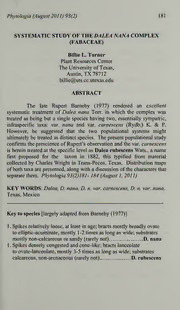
Systematic study of the Dalea nana complex (Fabaceae) PDF
Preview Systematic study of the Dalea nana complex (Fabaceae)
Phytologia (August2011) 93(2) 181 SYSTEMATIC STUDY OF THEDALEA NANA COMPLEX (FABACEAE) Billie L. Turner Plant Resources Center The University ofTexas, Austin, TX 78712 [email protected] ABSTRACT The late Rupert Bameby (1977) rendered an excellent systematic treatment of Dalea nana Torr. in which the complex was treated as being but a single species having two, essentially sympatric, & infraspecific taxa: var. nana and var. carnescens (Rydb.) K. P. However, he suggested that the two populational systems might ultimately be treated as distinct species. The present populational study confirms the prescience ofRupert's observation and the var. carnescens is herein treated at the specific level as Dalea rubescens Wats., a name first proposed for the taxon in 1882, this typified from material collected by Charles Wright in Trans-Pecos, Texas. Distribution maps ofboth taxa are presented, alongwith a discussion ofthe characters that separate them. Phytologia 93(2)181- 184 (August 1, 2011) KEY WORDS: Dalea, D. nana, D. n. var. carnescens, D. n. var. nana, Texas, Mexico Key to species [largely adapted from Bameby (1977)] 1. Spikes relatively loose, at least in age; bracts mostly broadly ovate to elliptic-acuminate, mostly 1-2 times as long as wide; substrates mostly non-calcareous or sandy (rarely not) D. nana 1. Spikes densely congestedand cone-like; bracts lanceolate to ovate-lanceolate, mostly 3-5 times as long as wide; substrates calcareous, non-arenaceous (rarely not) D. rubescens 182 Phytologia (August2011) 93(2) DALEA NANA Torr. ex A. Gray, Mem. Amer. Acad. 11,4 (PI. Fendl. 1): 31. 1849. TYPE: OKLAHOMA. CIMARRON CO.: "Willow Bar on the Cimarron." 28 Aug 1847, Fendler ISO (GH) [data from Shaw, 1982]. Parosela nana (Torr.) A. Heller Bameby (1977) presented an exceptional analysis of the D. nana complex nearly all of which I agree with, except as to nomenclatural bestowals. He aptly notedthat: Racial differentiation in var. nana is apparently still active, expressed in small size-differences in the spikes and in length of the bracts, calyx-teeth, and androecia. Material from the upper Arkansas (nomenclaturally typical) and thence southwest to Rio Grande and on, sporadically, into extreme southeast Arizona, has relatively thick spikes (10-13 mm diam), long bracts (3.5-5.5 mm) and calyx-teeth (2.6-4.2 mm), and long androecia (mostly 8-10 mm). The populations on the Coastal Plain in southern Texas and adjoining Mexico, extending into central Texas, have narrower mm spikes (mostly 7-9 diam), correspondingly short bracts (2.5-4, rarely 4.5 mm), calyx teeth (2.2-3.4, rarely 3.8 mm), and androecia (6-8 mm). These differences represent, however, trends rather than accomplished modifications, coinciding for the most part with different life-zones, but are not yet fully established. My study of the herbarium specimens at LL-TEX, SRSC largely confirm the observations of Bameby, and one might make a case for the recognition of an infraspecific category for the more southern populations of D. nana, with emphasis upon the characters called to the fore by Bameby, nearly all ofthese intergrading to some extendwith the more typical, northwestempopulations ofthe taxon. At least I could see little point in constmcting varietal names for the DNA populations concemed, but it will be interesting to see what data might suggest. Phytologia (August2011) 93(2) 183 DALEA RUBESCENS Wats., Proc. Amer. Acad. Arts 17: 369. 1882. LECTOTYPE: TEXAS. JEFF DAVIS CO.: Limpia Pass, NE ofFort Davis, Aug 1849, Charles Wright 124 (GH). Parosela carnescens Rydb. Parosela elatiorVail, nom. illeg. & Parosela lesueuriiTharp Barkley Dalea nana varelatiorA. Gray ex B.L. Turner, nom. illeg. (of. Bameby 1977) & Dalea nana var. carnescens (Rydb.) K. P. & Dalea whitehouseaeTharp Barkley Bameby (1977) notes that "Where it invades the territory of var. nandi, as in the lower Rio Grande valley and in contiguous south comers ofArizona and New Mexico, the two forms remain, whenever I have seen them, segregated by soil preference, var. carnescens always on limestone mbble, caliche, or gypsum, and var. nana on acidic or neutral sands." After a lengthy discussion of the variability of the varieties nana and carnescens, Bameby (1977) concluded, "It is possible that they should be recognized as distinct species, but (as mentioned above) occasional morphological intermediates occur, difficult to assign to variety (butnone, as yet, accompaniedby habitat data)." After considerable populational studies in central and Trans- Pecos, Texas I conclude that the two taxa concerned should be recognized at the specific level. Populations are readily identified, and when the two taxa are in close proximity they appear not to intergrade as a result of current hybridization, although it is possible that such might be found with more inclusive investigation. It is likely that ancient hybridization between the two taxa has occurred, this accounting for those plants that I assumed were possible extant hybrids of D. nana with D. aurea, (Tumer 1959), this called to the fore by Bameby (1977). According to Bameby, the species is named for the tendency of the yellow petals to tum fleshy pink or reddish upon drying. It is most readily recognized by its bracts, which are lanceolate and mostly 2.5-5.0 times as long as wide (vs broadly ovate and mostly 2.0-2.5 184 Phytologia (August2011) 93(2) times as long as wide.), these nicely illustrated in Shinners and Mahler's Illustrated Flora ofNorth Central Texas. ACKNOWLEDGEMENTS Distribution maps are based upon specimens on file at BRIT, SRSC and LL-TEX, for which I am grateful, supplemented by appropriate distributional data on the web pages (mainly USDA). Guy Nesom kindly reviewedthe paperandofferedhelpful suggestions. LITERATURE CITED Bameby, R.C. 1977. Dales., in Daleae imagines. Mem. New York Bot. Gard. 27: 135-587. Shaw, E.A. 1982. Augustus Fendlers collection list: New Mexico, 1846-1847. Contr. Gray Herb. 212: 1-70. Fig. 1. Distribution ofDalea nana.
